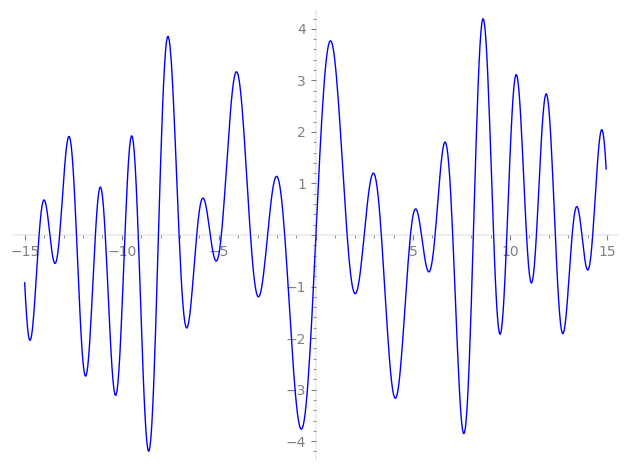| L(s) = 1 | + 4·2-s − 2.16·3-s + 16·4-s + 71.6·5-s − 8.67·6-s + 14.6·7-s + 64·8-s − 238.·9-s + 286.·10-s − 257.·11-s − 34.7·12-s − 106.·13-s + 58.5·14-s − 155.·15-s + 256·16-s − 1.22e3·17-s − 953.·18-s + 1.83e3·19-s + 1.14e3·20-s − 31.7·21-s − 1.03e3·22-s + 819.·23-s − 138.·24-s + 2.01e3·25-s − 426.·26-s + 1.04e3·27-s + 234.·28-s + ⋯ |
| L(s) = 1 | + 0.707·2-s − 0.139·3-s + 0.5·4-s + 1.28·5-s − 0.0984·6-s + 0.112·7-s + 0.353·8-s − 0.980·9-s + 0.906·10-s − 0.642·11-s − 0.0695·12-s − 0.175·13-s + 0.0797·14-s − 0.178·15-s + 0.250·16-s − 1.02·17-s − 0.693·18-s + 1.16·19-s + 0.640·20-s − 0.0157·21-s − 0.454·22-s + 0.323·23-s − 0.0492·24-s + 0.643·25-s − 0.123·26-s + 0.275·27-s + 0.0564·28-s + ⋯ |
\[\begin{aligned}\Lambda(s)=\mathstrut & 862 ^{s/2} \, \Gamma_{\C}(s) \, L(s)\cr =\mathstrut & -\, \Lambda(6-s) \end{aligned}\]
\[\begin{aligned}\Lambda(s)=\mathstrut & 862 ^{s/2} \, \Gamma_{\C}(s+5/2) \, L(s)\cr =\mathstrut & -\, \Lambda(1-s) \end{aligned}\]
Particular Values
| \(L(3)\) |
\(=\) |
\(0\) |
| \(L(\frac12)\) |
\(=\) |
\(0\) |
| \(L(\frac{7}{2})\) |
|
not available |
| \(L(1)\) |
|
not available |
\(L(s) = \displaystyle \prod_{p} F_p(p^{-s})^{-1} \)
| $p$ | $F_p(T)$ |
|---|
| bad | 2 | \( 1 - 4T \) |
| 431 | \( 1 - 1.85e5T \) |
| good | 3 | \( 1 + 2.16T + 243T^{2} \) |
| 5 | \( 1 - 71.6T + 3.12e3T^{2} \) |
| 7 | \( 1 - 14.6T + 1.68e4T^{2} \) |
| 11 | \( 1 + 257.T + 1.61e5T^{2} \) |
| 13 | \( 1 + 106.T + 3.71e5T^{2} \) |
| 17 | \( 1 + 1.22e3T + 1.41e6T^{2} \) |
| 19 | \( 1 - 1.83e3T + 2.47e6T^{2} \) |
| 23 | \( 1 - 819.T + 6.43e6T^{2} \) |
| 29 | \( 1 + 6.32e3T + 2.05e7T^{2} \) |
| 31 | \( 1 - 270.T + 2.86e7T^{2} \) |
| 37 | \( 1 + 3.40e3T + 6.93e7T^{2} \) |
| 41 | \( 1 + 1.48e4T + 1.15e8T^{2} \) |
| 43 | \( 1 - 4.40e3T + 1.47e8T^{2} \) |
| 47 | \( 1 + 2.85e3T + 2.29e8T^{2} \) |
| 53 | \( 1 + 3.35e3T + 4.18e8T^{2} \) |
| 59 | \( 1 + 4.67e4T + 7.14e8T^{2} \) |
| 61 | \( 1 + 1.87e4T + 8.44e8T^{2} \) |
| 67 | \( 1 - 5.78e4T + 1.35e9T^{2} \) |
| 71 | \( 1 - 2.62e4T + 1.80e9T^{2} \) |
| 73 | \( 1 + 2.21e4T + 2.07e9T^{2} \) |
| 79 | \( 1 - 4.14e4T + 3.07e9T^{2} \) |
| 83 | \( 1 + 6.68e4T + 3.93e9T^{2} \) |
| 89 | \( 1 + 7.10e4T + 5.58e9T^{2} \) |
| 97 | \( 1 - 9.55e4T + 8.58e9T^{2} \) |
| show more | |
| show less | |
\(L(s) = \displaystyle\prod_p \ \prod_{j=1}^{2} (1 - \alpha_{j,p}\, p^{-s})^{-1}\)
Imaginary part of the first few zeros on the critical line
−9.151521418686999599118582794675, −8.110464579532834562412361853459, −7.04751950341069856264478754672, −6.13882711809888883235836688941, −5.43908235607136071150824340458, −4.87032046981502570690891586647, −3.37084607756970633041505588246, −2.48825678091373381899622120787, −1.60730028226949565579717526663, 0,
1.60730028226949565579717526663, 2.48825678091373381899622120787, 3.37084607756970633041505588246, 4.87032046981502570690891586647, 5.43908235607136071150824340458, 6.13882711809888883235836688941, 7.04751950341069856264478754672, 8.110464579532834562412361853459, 9.151521418686999599118582794675

